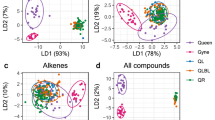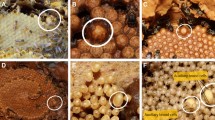Summary
Queens inMegaponera foetens are permanently wingless. In a colony from Kenya we observed that the ergatoid queen was often surrounded by a large number of workers, all conspicuously facing her. To investigate the nature of this attraction, we divided the colony in half. When the queen was transferred from one group to the other, a large court of workers formed immediately. When marked workers were transferred from the queenright group to the other, they attracted much attention and were licked repeatedly. These data suggest that the queen produces a chemical signal which attracts workers, and this signal is transferred onto the workers. In a histological investigation of queen and workers, we found many intersegmental glands in both castes. However, only the queen had a thick glandular epithelium lining her entire body, and this may be the source of her signal. The numerous erect setae covering the queen (but not the workers) may help to dispense the secretions. Our results confirm that ergatoid queens in the Ponerinae are morphologically specialized, despite their external similarity with workers.
Similar content being viewed by others
References
Arnold, G., 1915. A monograph of the Formicidae of South Africa.Annals of the South African Museum 14:1–766.
Burns, M. S. and A. Bretschneider, 1981.Thin is in. American Society of Clinical Pathologists, Educational Products Division, Chicago.
Crewe, R. M., C. Peelers and M. Villet, 1984. Frequency distribution of worker sizes inMegaponera foetens (Fabricius).S. Afr. J. Zool. 19:247–248.
Fanfani, A. and M. D. Valcurone, 1986. Glandole delle ponerine e ricerche sulle glandole del gastro diMegaponera foetens (Fab.) (Hymenoptera: Formicidae).Accademia Nazionale del Lincei 260:115–132.
Fletcher, D. J. C., 1973. “Army ant” behaviour in the Ponerinae: a reassessment. Proc. 7th Congr. IUSSI (London, 1973), 116–121.
Fletcher, D. J. C. and K. Ross, 1985. Regulation of reproduction in eusocial Hymenoptera.Ann. Rev. Entomol. 50:319–343.
Franks, N. R. and B. Hölldobler, 1987. Sexual competition during colony reproduction in army ants.Biol. J. Linnean Soc. 30:229–243.
Hagan, H. R., 1954. The reproductive system of the army-ant queen,Eciton (Eciton), part 3: The oocyte cycle.Am. Mus. Novit. 1665, 20 pp.
Hölldobler, B. and H. Engel, 1978. Tergal and sternal glands in ants.Psyche 85:285–330.
Hölldobler, B. and E. O. Wilson, 1983. Queen control in colonies of weaver ants (Hymenoptera: Formicidae).Ann. Ent. Soc. Am. 76:235–238.
Hölldobler, B. and S. Bartz, 1985. Sociobiology of reproduction in ants. In:Experimental behavioral ecology and sociobiology (B. Hölldobler and M. Lindauer, eds.). Sinauer Assoc., Sunderland, Mass., pp. 237–257.
Hölldobler, B., J. Palmer, K. Masuko and W. L. Brown, 1989. New exocrine glands in the legionary ants of the genusLeptanilla (Hymenoptera, Formicidae, Leptanillae).Zoomorphol. 108:255–261.
Jessen, K. and U. Maschwitz, 1983. Abdominaldrüsen beiPachycondyla tridentata (Smith) (Formicidae, Ponerinae).Ins. Soc. 30:123–133.
Jessen, K., U. Maschwitz and M. Hahn, 1979. Neue Abdominaldrüsen bei Ameisen. I. Ponerini (Formicidae: Ponerinae).Zoomorphologie 94:46–66.
Lepage, M. G., 1981. Etude de la prédation deMegaponera foetens (F.) sur les populations récoltantes de Macrotermitinae dans un écosystème semi-aride (Kajiado — Kenya).Ins. Soc. 28:247–262.
Lévieux, J., 1966. Note préliminaire sur les colonnes de chasse deMegaponera foetens F. (Hymenoptera: Formicidae).Ins. Soc. 13:117–126.
Lévieux, J., 1967. Recherches écologiques dans la savane de Lamto (Côte d'Ivoire): données préliminaires sur le peuplement en fourmis terricoles.La Terre et la Vie 3:278–296.
Longhurst, C., R. A. Johnson and T. G. Wood, 1978. Predation byMegaponera foetens (Fab.) (Hymenoptera: Formicidae) on termites in the Nigerian Southern Guinea Savanna.Oecologia 32:101–107.
Longhurst, C. and P. E. Howse, 1979a. Foraging, recruitment and emigration inMegaponera foetens (Fab.) (Hymenoptera: Formicidae) from the Nigerian Guinea Savanna.Ins. Soc. 26:204–215.
Longhurst, C. and P. E. Howse, 1979b. Some aspects of the biology of the males ofMegaponera foetens (Fab.) (Hymenoptera: Formicidae).Ins. Soc. 26:85–91.
Longhurst, C., R. Baker and P. E. Howse, 1979. Termite predation byMegaponera foetens (Fab.) (Hymenoptera: Formicidae). Coordination of raids by glandular secretions.J. Chem. Ecol. 5: 703–719.
Passera, L., 1984.L'organisation sociale des fourmis. Privat, Toulouse. 360 pp.
Peeters, C., 1991. Ergatoid queens and intercastes in ants: two distinct adult forms which look morphologically intermediate between workers and winged queens.Ins. Soc. 38:1–15.
Peeters, C., 1993. Monogyny and polygyny in ponerine ants with or without queens In:Queen number and sociality in insects (L. Keller, ed.) Oxford University Press.
Rettenmeyer, C. W., H. Topoff and J. Mirenda, 1978. Queen retinues of army ants.Ann. Ent. Soc. Am. 71:519–528.
Rettenmeyer, C. W. and J. F. Watkins, 1978. Polygyny and monogyny in army ants (Hymenoptera: Formicidae).J. Kans. Entomol. Soc. 51:581–591.
Seeley, T. D., 1979. Queen substance dispersal by messenger workers in honeybee colonies.Behav. Ecol. Sociobiol. 5:391–415.
Spurr, A. R., 1969. A low viscosity epoxy resin embedding medium for electron microscopy.J. Ultrastruct. Res. 26:31–43.
Villet, M., 1990. Division of labour in the Matabele antMegaponera foetens (Fabr.) (Hymenoptera Formicidae).Ethol. Ecol. Evol. 2:397–417.
Villet, M., C. P. Peeters and R. M. Crewe, 1984. The occurrence of a pygidial gland in four genera of ponerine ants (Hymenoptera: Formicidae).J. Georgia Ent. Soc. 19:413–416.
Villet, M. and F. D. Duncan, 1992. Reproductive abilities of orphaned workers of two ponerine ant species (Hymenoptera, Formicidae).J. ent. Soc. sth. Afr. 55:280–282.
Whelden, R. M., 1963. Anatomy of adult queen and workers of army antsEciton burchelli Westw. andE.hamatum Fabr. (Hymenoptera: Formicidae).J. N. Y. Ent. Soc. 71(1):14–30; (2): 90-115; (3):158-178; (4):246-261.
Author information
Authors and Affiliations
Rights and permissions
About this article
Cite this article
Hölldobler, B., Peeters, C. & Obermayer, M. Exocrine glands and the attractiveness of the ergatoid queen in the ponerine antMegaponera foetens . Ins. Soc 41, 63–72 (1994). https://doi.org/10.1007/BF01240573
Received:
Revised:
Accepted:
Issue Date:
DOI: https://doi.org/10.1007/BF01240573




